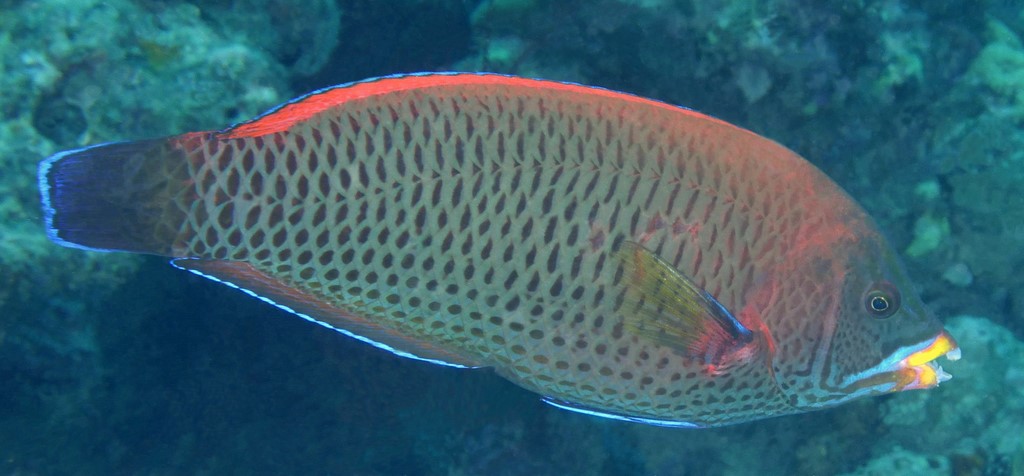PSEUDODAX MOLUCCANUS - (VALENCIENNES, 1840)
Actinopterygii (Gigaclass) > Actinopteri (Class) > Teleostei (Subclass) > Perciformes (Order) > Labroidei (Suborder) > Labridae (Family) > Pseudodax (Genus)
Labre des Moluques, Labre indigo, Vieille ciseau, Chiseltooth wrasse, Chisel-tooth wrasse, Meisselzahn-Lippfisch, Meißelzahn-Lippfisch, Beiteltand-lipvis, Bodião tesoura, Vieja cuchilla, Budaibera, ブダイベラ, 拟鹦鲷, 桔点拟凿牙鱼,
Synonymes
Odax borbonicus (Valenciennes, 1840)
Odax moluccanus (Valenciennes, 1840)
Odax varius (Valenciennes, 1840)
Pseudodax mollucanus (Valenciennes, 1840)
Pseudodax molluccanus (Valenciennes, 1840)
Pseudodax moluccensis (Günther, 1862)
Pseudodax molucanus (Valenciennes, 1840)
Pseudodax moluccans (Valenciennes, 1840)
----------------------------
Description
Dorsal spines (total): 11; Dorsal soft rays (total): 12; Anal spines: 3; Anal soft rays: 14; Pectoral fin rays: 15; Gill rakers : 16-19. Lateral line continuous, without sharp bend below rear of dorsal fin, Lateral line scales: 30-31; Body moderately deep. Body depth: 2.5-3.4 in SL, deeper-bodied with growth; Head profile of adults straight to above eyes, then slightly convex on nape; Mouth small; Jaws prominent; Two prominent spatulate incisors anteriorly in each jaw, those of lower jaw followed by a second pair; Remaining teeth in jaws meet in a cutting ridge. Lateral line continuous with no sharp bend. Head scaly except for interorbital, snout, and chin. Spines and rays of dorsal and anal fins increasing gradually to penultimate ray; Sheath of small scales at base of dorsal and anal fins; Large scales on basal half of caudal fin, last row pointed. Caudal fin slightly rounded. Max. length: 30.0 cm TL. Depth: 3 - 60 m, usually: 4 - 40 m.
Color
Juveniles are pale blue with a broad midbody stripe.
Etymology
Pseudodax: from Greek, pseudes = false + from Greek, odax = with the teeth. Although this genus may resemble Odax, with its one species previously placed in it, such an appearance is false.
moluccanus: from Molucca Islands, Indonesia, type locality + from Latin suffix, –anus = belonging to.
Original description: Odax moluccanus Valenciennes, 1840 - Type locality: Molucca Islands, Indonesia.
Distribution
Biology
Inhabits clear channels and seaward reefs. Juveniles are commonly found along drop-offs. Adults usually found near caves while juveniles frequently live inside them. Adults are solitary and feed on algae and small invertebrates. Juveniles resemble cleaner wrasse of the genus Labroides and also remove external parasites form other fishes. Because of its dentition, it is regarded as a close relative to the parrotfishes (Scaridae), although it behaves like the species of Anampses. Oviparous, distinct pairing during breeding. Aquarium fish.
Last update: 7, april 2023
Labre des Moluques, Labre indigo, Vieille ciseau, Chiseltooth wrasse, Chisel-tooth wrasse, Meisselzahn-Lippfisch, Meißelzahn-Lippfisch, Beiteltand-lipvis, Bodião tesoura, Vieja cuchilla, Budaibera, ブダイベラ, 拟鹦鲷, 桔点拟凿牙鱼,
Synonymes
Odax borbonicus (Valenciennes, 1840)
Odax moluccanus (Valenciennes, 1840)
Odax varius (Valenciennes, 1840)
Pseudodax mollucanus (Valenciennes, 1840)
Pseudodax molluccanus (Valenciennes, 1840)
Pseudodax moluccensis (Günther, 1862)
Pseudodax molucanus (Valenciennes, 1840)
Pseudodax moluccans (Valenciennes, 1840)
----------------------------
Description
Dorsal spines (total): 11; Dorsal soft rays (total): 12; Anal spines: 3; Anal soft rays: 14; Pectoral fin rays: 15; Gill rakers : 16-19. Lateral line continuous, without sharp bend below rear of dorsal fin, Lateral line scales: 30-31; Body moderately deep. Body depth: 2.5-3.4 in SL, deeper-bodied with growth; Head profile of adults straight to above eyes, then slightly convex on nape; Mouth small; Jaws prominent; Two prominent spatulate incisors anteriorly in each jaw, those of lower jaw followed by a second pair; Remaining teeth in jaws meet in a cutting ridge. Lateral line continuous with no sharp bend. Head scaly except for interorbital, snout, and chin. Spines and rays of dorsal and anal fins increasing gradually to penultimate ray; Sheath of small scales at base of dorsal and anal fins; Large scales on basal half of caudal fin, last row pointed. Caudal fin slightly rounded. Max. length: 30.0 cm TL. Depth: 3 - 60 m, usually: 4 - 40 m.
Color
Juveniles are pale blue with a broad midbody stripe.
Subadults have a yellow band on the tail base.
Adults greenish or bluish grey, with reddish brown spot on each scale of body (vertically elongate dorsally, round ventrally); Wash of orange on nape and dorso-anteriorly on body; Upper lip mainly yellow with blue streak above extending across lower cheek; Teeth blue; Caudal fin deep purple to dark blue with narrow blue margin and broad yellowish white bar across base; Dorsal and anal fins dull orange-yellow with faint dark markings, blue margin and black submarginal band; Pectoral fins with yellow rays and blackish streak dorsally at base, with blue dorsal margin; Juveniles dark brown with two bright blue stripes, one dorsal and one ventral, that narrow posteriorly on body and extend anteriorly onto head.
Etymology
Pseudodax: from Greek, pseudes = false + from Greek, odax = with the teeth. Although this genus may resemble Odax, with its one species previously placed in it, such an appearance is false.
moluccanus: from Molucca Islands, Indonesia, type locality + from Latin suffix, –anus = belonging to.
Original description: Odax moluccanus Valenciennes, 1840 - Type locality: Molucca Islands, Indonesia.
Distribution
Red Sea; Indo-West Pacific: KwaZulu-Natal (South Africa), East Africa, Socotra (Yemen), Seychelles, Aldabra (Seychelles), Comoros, Madagascar and western Mascarenes (La Réunion, Mauritius) east to Marquesas Islands and Tuamotu Archipelago (French Polynesia), north to Kagoshima Prefecture (southern Japan) and Ogasawara Islands (Japan), south to New Caledonia and Tonga.
Biology
Inhabits clear channels and seaward reefs. Juveniles are commonly found along drop-offs. Adults usually found near caves while juveniles frequently live inside them. Adults are solitary and feed on algae and small invertebrates. Juveniles resemble cleaner wrasse of the genus Labroides and also remove external parasites form other fishes. Because of its dentition, it is regarded as a close relative to the parrotfishes (Scaridae), although it behaves like the species of Anampses. Oviparous, distinct pairing during breeding. Aquarium fish.
Last update: 7, april 2023
